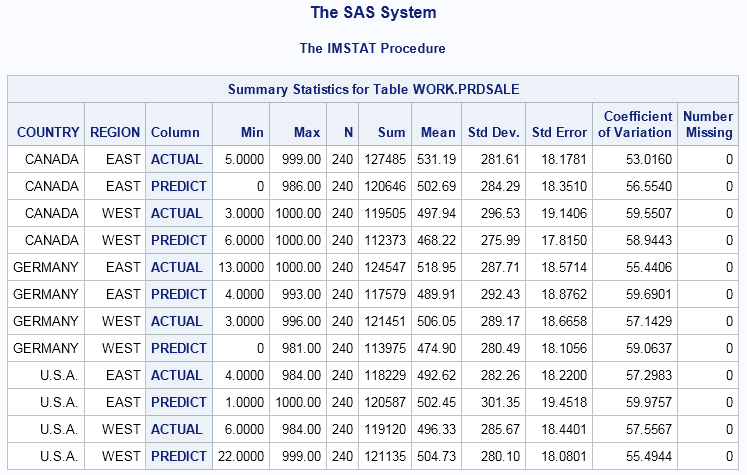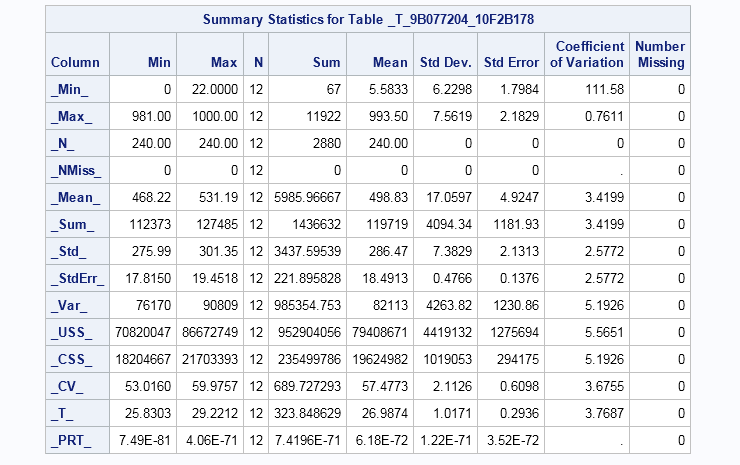IMSTAT Procedure (Data and Server Management)
- Syntax
 Procedure SyntaxPROC IMSTAT (Data and Server Management) StatementBALANCE StatementCOLUMNINFO StatementCOMPRESS StatementCOMPUTE StatementCREATETABLE StatementDELETEROWS StatementDISTRIBUTIONINFO StatementDROPCOLUMN StatementDROPTABLE StatementFETCH StatementFREE StatementLIFETIME StatementNUMROWS StatementPARTITION StatementPARTITIONINFO StatementPROMOTE StatementPURGETEMPTABLES StatementREPLAY StatementSAVE StatementSCHEMA StatementSCORE StatementSERVERINFO StatementSERVERPARM StatementSERVERTERM StatementSERVERWAIT StatementSET StatementSTORE StatementTABLE StatementTABLEINFO StatementUNCOMPRESS StatementUPDATE StatementQUIT Statement
Procedure SyntaxPROC IMSTAT (Data and Server Management) StatementBALANCE StatementCOLUMNINFO StatementCOMPRESS StatementCOMPUTE StatementCREATETABLE StatementDELETEROWS StatementDISTRIBUTIONINFO StatementDROPCOLUMN StatementDROPTABLE StatementFETCH StatementFREE StatementLIFETIME StatementNUMROWS StatementPARTITION StatementPARTITIONINFO StatementPROMOTE StatementPURGETEMPTABLES StatementREPLAY StatementSAVE StatementSCHEMA StatementSCORE StatementSERVERINFO StatementSERVERPARM StatementSERVERTERM StatementSERVERWAIT StatementSET StatementSTORE StatementTABLE StatementTABLEINFO StatementUNCOMPRESS StatementUPDATE StatementQUIT Statement - Overview
- Concepts
- Examples

Concepts: IMSTAT Procedure
Partitioned Tables
A SAS LASR Analytic Server
table can be partitioned, and it can also be ordered within each partition.
A partition is a collection of observations that share the same key
value and are located on the same worker node. The key value can be
constructed from one or more variables. The partitioning keys are
created according to the formatted values of the specified variables.
Partitioning of data is an important tool in managing distributed
data sources. The process of partitioning can consume computing and
network resources as well as create greater imbalance in the data
compared to a round-robin distribution. However, partitioned data
can be accessed more quickly and subsequent procedure statements can
execute more quickly.
You can achieve a partitioned
table as follows:
For
more information, see Data Partitioning and Ordering.
RUN-Group Processing
The IMSTAT procedure
supports RUN-group processing. RUN-group processing enables you to
submit RUN groups without ending the procedure. This feature is particularly
useful for running SAS interactively. You can start the procedure
with the PROC IMSTAT statement and then execute statements like SUMMARY
and FREQUENCY. Each statement runs when it reaches a RUN statement.
To use RUN-group processing,
you start the procedure and then submit multiple RUN-groups. A RUN-group
is a group of statements that contains at least one action statement
and ends with a RUN statement. As long as you do not terminate the
procedure, it remains active and you do not need to resubmit the PROC
statement.
WHERE Clause Processing
There are two important
features for WHERE clause processing that are related to the IMSTAT
procedure. The first is that the WHERE clause is applied to the data
by the server. When you use a WHERE clause to subset data, the subsetting
is performed by the server. Only the rows that meet the WHERE clause
criteria are affected by subsequent operations.
The second important
feature for WHERE clause processing is related to the RUN-group processing
that the IMSTAT procedure supports. You can modify the WHERE clause
between statements. Unless a WHERE clause is specified in a RUN block,
no subsetting of rows occurs. In the following code example, the SUMMARY
statement in the first RUN-group is not subject to a WHERE clause.
The FREQUENCY statement in the second RUN-group applies only to observations
for which Division='EDUCATION.'
proc imstat data=example.prdsale(tag=sashelp);
summary actual predict / groupby=(region);
run;
where division='EDUCATION';
frequency prodtype;
run;
If you specify WHERE
clauses in different RUN blocks, the clauses replace each other. A
note is written to the SAS log to indicate the change. For example,
the SUMMARY statement in the following code example applies to observations
for which the Division='CONSUMER.' The FREQUENCY statement
applies to observations for which Region='EAST.'
proc imstat data=example.prdsale(tag=sashelp);
where division='CONSUMER';
summary actual predict / groupby=(region);
run;
where region='EAST';
frequency prodtype;
run;
When the FREQUENCY
statement runs, the following line is added to the SAS log.
NOTE: WHERE clause has been replaced.
WHERE clauses can remain
active across RUN statements. The following example is the same as
the previous example, except that the second WHERE clause is not submitted.
proc imstat data=example.prdsale(tag=sashelp);
where division='CONSUMER';
summary actual predict / groupby=(region);
run;
/* where region='EAST'; */
frequency prodtype;
run;
In this case, the SAS
log includes the following note.
NOTE: A WHERE clause remains active from a previous RUN
block: '(division='CONSUMER')'.
Each time you access
a different table with the TABLE statement, the WHERE clause is cleared.
In following example, the second FREQUENCY statement is not restricted
to observations for which Region='EAST' because the TABLE
statement that accesses Prdsal2 clears the WHERE clause.
Temporary Tables
A temporary table is
an in-memory table that contains the result set of a procedure statement.
Instead of transferring the results to the client SAS session, the
results remain in the server and only the name of the temporary table
is transferred to the client. You can then use other procedure statements
with the temporary table.
Temporary tables can
be partitioned and the SUMMARY, CROSSTAB, DISTINCT, and PERCENTILE
statements perform this action. For non-partitioned data, you can
also generate temporary tables with the SUMMARY and CROSSTAB statements,
provided that you request a GROUPBY analysis.
The following DATA
step shows how to create a partitioned table on the variables Country
and Region.
data lasr.prdsale(partition=(country region));
set sashelp.prdsale;
run;
The following statements
generate a summary analysis for variables Actual and Predict in each
of the partitions.
proc imstat; table lasr.prdsale; summary actual predict / partition; run;
As an alternative,
you can leave the result set in an in-memory table by adding the TEMPTABLE
option to the SUMMARY statement:
summary actual predict / partition temptable; run;
The temporary table
is assigned a name by the server. When the IMSTAT procedure ends,
any temporary tables created during the procedure run are removed
from the server. Since the generated name is not predictable, the
procedure assigns the name of the most recently generated temporary
table to the _TEMPLAST_ macro variable.
You can use the TABLE
statement to switch the active table to the temporary table and perform
analyses. Make sure that the statement that generated the temporary
table is separated from the next statement with a RUN statement. Otherwise,
you receive an error that the table specified in the TABLE statement
does not exist. The temporary table does not exist at parse time,
it is created at run time when the statement is executed.
Creating Temporary Tables with GROUPBY Variables
Temporary tables play
an important role in partitioning in the server. Temporary tables
that are created by the DISTINCT, SUMMARY, CROSSTAB, or PARTITION
statements are partitioned.
If the input table is
not partitioned, you can still use temporary tables with the SUMMARY
and CROSSTAB statements, provided that you perform a group-by analysis.
The temporary table that is created by the server is automatically
partitioned by the group-by variables. This potentially involves a
redistribution of the groups in the result set to transfer all the
result records for a particular group to the same worker node.
Creating Temporary Variables
You can use temporary
variables in a table. For example, if a table has variables that are
named x1, x2, and x3, you can calculate the summary statistics for
variable d1 = x1 + x2 / 3*x3. One way is to declare d1 as a temporary
variable of the table (with data set options for the input table).
You can use the temporary variables (temporary for the duration of
each statement) with DATA step expression scripts.
proc imstat data=lasrlib.table1(array=(d,1));
summary d1 x1 -- x3 / tempnames=d1 tempexpress="d1 = x1 + x2 / 3*x3;";
run;
summary d1 / tempnames=d1 tempexpress="d1 = mean(x1, x2);";
quit;Because the temporary
variable exists for the duration of the statement, its name can be
reused in subsequent statements. The second SUMMARY statement uses
the same name, d1, for the temporary variable but it has a different
value.
You can also create temporary character variables. The
following example creates a program that concatenates the first character
of the Type variable and the first character of the Origin variable.
libname lasrlib sasiola host="hostname.example.com" port=10010 tag=hps;
data lasrlib.cars; set sashelp.cars; run;
data _null_;
file 'concat.sas';
put "c1 = substr(type,1,1) || substr(origin,1,1);";
run;
filename fref 'concat.sas';
proc imstat;
table lasrlib.cars(tempnames=(c1 $)); 1
summary horsepower / groupby=c1 tn=(c1) te=fref; 2
run;
crosstab c1*type / tn=(c1) te=fref;
run;| 1 | The TEMPNAMES= data set option for the SAS LASR Analytic Server engine reserves the variable name, c1, for the temporary variable that does not exist. The $ indicates that it is a character variable. |
| 2 | The temporary variable name can be used in a variety of expressions. The TEMPNAMES= and TEMPEXPRESS= options must be specified in every statement that uses the temporary variable. |
Copyright © SAS Institute Inc. All rights reserved.


